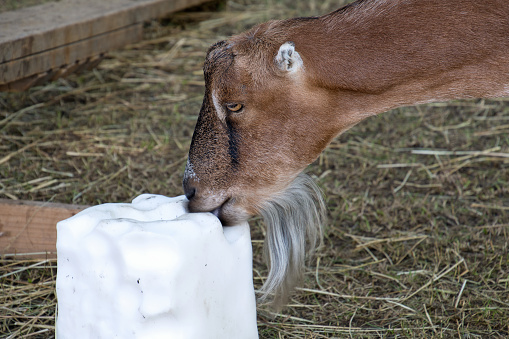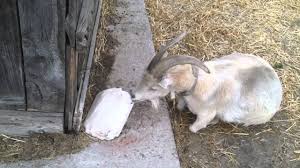In this article, we are going to look at the ways by which we can make a baby goat kid lick a block i.e. how to care for a baby goat. If you want to raise goats sooner or even later, then it is a must that you have baby goats to care for, most especially if you want to raise them for milking.
Before we go further, many of you may want to know what a baby goat name is, or ask direct questions like what is a baby goat called? Well… to answer this question, A baby goat is called a kid, which is why we addressed them here as baby goat kid.
Providing a goat kid with the right care, like learning how to feed well, when to feed, managing the birth, and how to even maintain its shelter is very important and critical to helping the goat kid grow into a healthy and hearting adult goat.
You should be present immediately and at the exact time that the baby goat is born so that the baby goat can start getting accustomed i.e get used to human contact.
Ways to Properly Take Care of Your Baby Goats
The following are the main actions to be taken after a baby goat is born:
Caring for the umbilical cord
It is very good for you to allow the umbilical cord to break naturally by itself, then it is advisable you trim it, and if not longer than four inches, just allow it to break naturally.
Make sure you use a sterilized pair of scissors, after that you can clean the cord with iodine gently and properly. Then you allow the stub to fall off naturally by itself.
Allow the mother and baby bond
It is important you leave the baby goat with the mother especially during the early stages of the baby goat’s life.
The mother will lick the baby goat very clean in that process, the baby goat and the mother will bond (close relationship), also sometimes you are to stay behind and monitor them because the mother goat may likely eat some of her kids after birth if care is not taken.
Read Also: Goats eating Nylon and What you should do
 Cute baby goat
Cute baby goat
Feed the baby goat with colostrum
It is very good and important you allow the baby goat to feed on its mother for the first 4-5 hours after birth.
In the case where the baby goat refuses to feed on its mother, then you can bottle-feed its colostrum which is the early milk that is very high in nutrients and also in immune-building properties to the baby goat.
This colostrum can be bought or gotten from a feed store or its mother, it is very good you decide before the goat kid is born.
Although I recommend that you allow the mother to nurse and raise the baby goat herself.
Bottle feed is also good because it is usually more attached to humans, tamer, and less skittish.
You can leave the baby goat with its mother even though you want to bottle feed for at least a few days so that the baby goat can get the rich nutrient colostrum into its system first, it is another less work on your part if you allow the mother to nurse her baby by herself.
Also, you will not need to feed or milk dam the baby goat. You will need to teach your baby goat how to drink from a bottle if you want to bottle feed them.
At least for the first 1 – 2 months, the baby goat should be fed at least 4 times a day.
It is very important you follow the advice of your vet to know the exact amount of milk to feed your baby goat and should in case there is any other supplement that is needed and recommended.
Read Also: Causes of Regular Abortion on Pregnant Goats and Control Measures
The following are some items you will need if you want to bottle feed your baby goat:
1. Goat baby bottle
2. The goat milk replacement formula
3. Kid nipple
4. Colostrum replacement if it is necessary
At least at one week, you can start giving your baby goat a small amount of grains to help jump-start the baby goat’s rumen development, then at one month, you can then proceed to give them hay, a small amount of grain, fresh water and also pasture time.
Also at this one month, you start to gradually decrease the amount of milking you are giving to the goat until your baby goat finally starts eating like an adult goat.
After then make sure you provide your goat kid with loose goat minerals in order to support their muscle growth and milk lactation.
In summary, below are the recommended ways to care for your baby goats properly;
Milk is the only source of food for goat kids until they develop the ability to be able to digest other feedstuffs which they will begin to develop from three to four weeks of age and complete by eight to nine weeks of age.
Make sure newborn goats are breathing by removing any material from around the mouth and nose, cleaning, and then drying the kid goat with a clean towel or rag.
Read Also: 10 Impressive Health Benefits and Uses of Parsley

If you can gently insert a piece of straw gently up the nasal passage, it will help stimulate breathing in a weak baby goat.
Keep them warm and dry by providing clean, dry, and soft bedding.
Make sure you change the bedding when it gets wet or adds more bedding.
And if the bedding is too cold you can wrap kids in a warm towel.
Ensure you cut the umbilicus navel cord as earlier stated. Help weak babies stand up.
It is very important that baby goats suckle and ingest enough colostrum immediately after birth.
Kids should be removed from their mothers at birth if the mother is known to have some diseases which can easily infect the child.
Also make sure the premises are well ventilated, safe from predators as this will help to minimize the chance of infections.
In conclusion, as earlier stated, a mother’s health and maternal ability are very important for the survival and the growth of the goat kids. The good health of the mother is very necessary for their own survival and continuous successful breeding during their productive lives. To crown it all, mothers also must be properly monitored and also cared for in order for them to successfully raise their kids.
Read Also: The Ultimate Step-by-Step Guide to Vegetable Gardening
Frequently Asked Questions
We will update this section soon.

